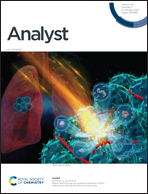Coupling strand extension/excision amplification with target recycling enables highly sensitive and aptamer-based label-free sensing of ATP in human serum
Abstract
Detection of aberrant ATP concentrations with high sensitivity and selectivity is of critical importance for monitoring many biological processes and disease stages. By coupling extension/excision amplification with target recycling, we have established an aptamer-based method for label-free fluorescence ATP detection in human serum with high sensitivity. The ATP target molecules associate with the aptamer-containing double hairpin probes and cause conformational changes of the probes to initiate the cyclic strand extension/excision processes in the presence of polymerase, endonuclease and assistance sequences for the recycling of ATP and the production of a large number of G-quadruplex sequences. The organic dye thioflavin T subsequently binds these G-quadruplex sequences to yield substantially enhanced fluorescence emission for achieving highly sensitive detection of ATP down to 2.2 nM in the range of 5 to 200 nM without using any labels. The developed aptamer sensing method also exhibits high selectivity and allows the monitoring of ATP at low concentrations in diluted real samples, which offers promising opportunities to establish effective signal magnification means for the detection of various biomolecules at trace levels.



 Please wait while we load your content...
Please wait while we load your content...